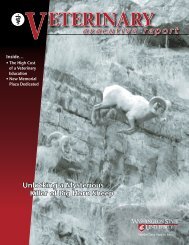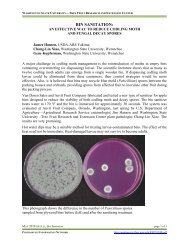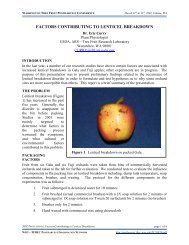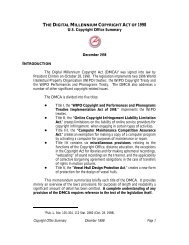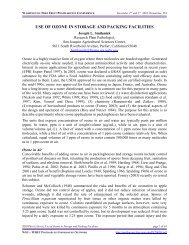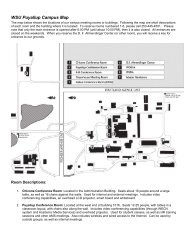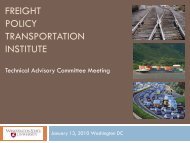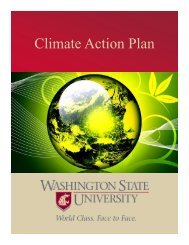No-Till: The Quiet Revolution - Research - Washington State University
No-Till: The Quiet Revolution - Research - Washington State University
No-Till: The Quiet Revolution - Research - Washington State University
Create successful ePaper yourself
Turn your PDF publications into a flip-book with our unique Google optimized e-Paper software.
[A CASE FOR NO-TILL]PAY DIRTand gaps in knowledge, experience or technologycan have potentially disastrous outcomes. Ifthe perception that no-till is riskier than conventionaltechniques develops in a farming community,banks may not underwrite a no-till farmer’sloan. Alternatively, growers who are leasing landmay find that the owners are opposed to no-tillbecause of fears that they will not get paid asmuch. Improving the quality of information<strong>The</strong> slow pace at which soil rebuilds makes its conservation essential By David R. Montgomeryexchange among farmers, universities, agribusinessesand government agencies will no doubt goa long way toward overcoming these obstacles.Yet even in the hands of a seasoned no-tillfarmer, the system has drawbacks. <strong>No</strong>-till cropproduction on fine-textured, poorly drainedsoils can be particularly problematic, oftenresulting in decreased yields. Yields of no-tillcorn, for instance, are often reduced by 5 to 10fundamental drawback of conventional farming is that it fostersA topsoil erosion, especially on sloping land. <strong>Till</strong>age leaves theground surface bare and vulnerable to runoff, and each pass of the plowpushes soil downhill. As a result, the soil thins over time. How long thisprocess takes depends not only on how fast plowing pushes soil downhill—andwind or runoff carries it away—but also on how fast theunderlying rocks break down to form new soil.In the 1950s, when the Soil Conservation Service (now known as theNatural Resources Conservation Service) began defining tolerable ratesof soil erosion from agricultural land, hardly any data on rates of soilproduction were available. <strong>The</strong> agency thus determined the so-calledsoil loss tolerance values, or T values, on the basis of what farmers coulddo to reduce erosion without“undue economicimpact” using conventionalfarming equipment. <strong>The</strong>se Tvalues correspond to asmuch as an inch of erosionin 25 years. But recentresearch has shown thaterosion rate to be far fasterthan the rate at which soilrebuilds.Over the past severaldecades, scientists havedetermined that measuringthe soil concentrations ofcertain isotopes that form ata known rate permits directquantification of soil productionrates. Applying thistechnique to soils in temperateregions in coastal California and southeastern Australia, geologistArjun Heimsath of Arizona <strong>State</strong> <strong>University</strong> and his colleagues found soilproduction rates ranging from 0.00118 to 0.00315 inch a year. As such,it takes 300 to 850 years to form an inch of soil in these places. My ownrecent global compilation of data from soil production studies, publishedlast year in the Proceedings of the National Academy of SciencesUSA, revealed an average rate of 0.00067 to 0.00142 incha year—equivalent to 700 to 1,500 years to form an inch of soil.<strong>The</strong> soil on undisturbed hillsides in temperate and tropical latitudes isgenerally one to three feet thick. With natural soil production rates ofWIND EROSION in the Southern Plains of the U.S. during the Dust Bowl erarevealed the perils of plow-based farming.centuries to millennia per inch and soil erosion rates of inches per centuryunder plow-based agriculture, it would take just several hundred to acouple of thousand years to plow through the soil in these regions. Thissimple estimate predicts remarkably well the life span of major agriculturalcivilizations around the world. With the exception of the fertile rivervalleys along which agriculture began, civilizations generally lasted 800to 2,000 years, and geoarchaeological studies have now shown a connectionbetween soil erosion and the decline of many ancient cultures.Clearly, then, if we are to conserve resources for future generations,we need alternatives to conventional farming practices. <strong>No</strong>-till systemssimultaneously reduce the erosive force of runoff and increase the abilityof the ground to hold onto soil, making these methods remarkably effectiveat curbing erosion. In astudy published in 1993,researchers at the <strong>University</strong> ofKentucky found that no-tillmethods decreased soil erosionby a whopping 98 percent. Morerecently, investigators at the<strong>University</strong> of Tennessee reportedthat no-till tobacco farmingreduced soil erosion by morethan 90 percent over conventionaltobacco cultivation.Although the effect of no-till onerosion rates depends on a numberof local factors, such as thetype of soil and the crop, it canbring soil erosion rates downclose to soil production rates.In the mid-1990s Cornell<strong>University</strong> researchers estimatedthat undoing damage caused by soil erosion would cost the U.S.$44 billion a year, and that it would take an annual investment of about$6 billion to bring erosion rates on U.S. cropland in line with soil production.<strong>The</strong>y also estimated that each dollar invested in soil conservationwould save society more than $5. Because it is prohibitively expensiveto put soil back on the fields once it leaves, the best, most cost-effectivestrategy for society at large is to keep it on the fields in the first place.David R. Montgomery is a professor of geomorphology at the <strong>University</strong>of <strong>Washington</strong> and author of Dirt: <strong>The</strong> Erosion of Civilizations.GETTY IMAGES76 SCIENTIFIC AMERICAN © 2008 SCIENTIFIC AMERICAN, INC.July 2008



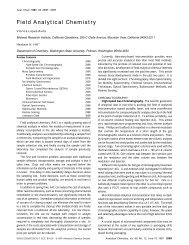
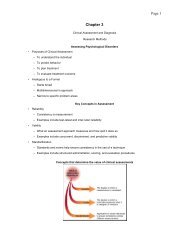


![Graduate School Policies & Procedures Manual 2011 - 2012 [PDF]](https://img.yumpu.com/50747405/1/190x245/graduate-school-policies-procedures-manual-2011-2012-pdf.jpg?quality=85)
